Ready to drive incremental growth with influencers?
If ditching the randomness of influencer campaigns and building a predictable, ROI-first influencer program sounds like a plan. Consider talking to our team!

Influencer Marketing
Rising CAC shows the old DTC playbook is broken. See how influencer marketing builds awareness, protects margins, and powers more efficient performance marketing.
Contents
This DTC playbook worked for many years: build a product, set up a Shopify store, and pump money into Facebook ads. Revenue kept coming because there was less competition, and untapped audience.
But that playbook is broken
Check your dependency on Meta ads, or paid traffic. If it's 70% of your budget, that’s an unhealthy dependence on one channel.
At the beginning it'll feel like you're on right track because you're getting consistent results. But when you first start running Facebook ads, you're targeting these ‘in-market’ buyers and seeing great results. And eventually, you run out of those people.
Two years in, you're showing your ads to the same audience over and over, which is why your CAC keeps inflating.
Without an active motion to bring those 97% into the 3% and keep refreshing that buying pool on a monthly basis, your ads will continue to plateau.
Most teams respond to this pressure by doubling down on what they know: better ad creative, smarter targeting, new campaign structures, A/B testing everything.
There's an illusion that the next creative hack or audience insight will solve the fundamental problem. But these tactics just keep brands running faster on the same treadmill of more spend equals more revenue.
The brands breaking free from this cycle are the ones who understand that performance marketing works exponentially better when people already know the brand and relate to it.

Before you walk into your next team meeting proposing to invest in brand awareness and brand building (and watching everyone's eyes glaze over), you need compelling reasons that make business sense.
Let's see why building a brand and awareness will improve your performance marketing results, with reasoning that will resonate with even your most numbers-focused team members:
Performance ads from new, little known brands have to do three jobs:
That's a lot to accomplish in a few seconds of someone's attention.
When people already know your brand, your performance ads only need to do one job: drive action.
They can skip straight to the offer, the urgency, or the product benefits because the trust and credibility work has already been done elsewhere.
This makes your ad creative more effective and your conversion rates higher with the exact same targeting and budget.
New brands often have to lead with aggressive discounts or risk-free offers because that's the only way to overcome the trust barrier with cold audiences. This trains your audience to expect discounts and can hurt your margins.
When people already trust your brand, your performance ads can focus on product benefits, new launches, or smaller incentives while maintaining strong conversion rates. This protects your pricing power and improves your unit economics from performance marketing.
Facebook and Google's algorithms optimize based on who converts from your ads.
When only risk-tolerant early adopters convert (because they're the only ones willing to buy from new brands), the platforms learn to find more people like them, limiting your potential audience.
But, when people with higher brand awareness convert at better rates, the algorithms learn to find broader audiences that actually convert.
Your lookalike audiences become more effective, your interest targeting works better, and your campaign scaling improves because the platforms have better conversion data to work with.
When people know and trust your brand, you can charge higher prices without losing customers.
New brands often have to compete primarily on price, which erodes margins over time.
Strong brand awareness gives you pricing power, which means you can maintain higher margins even as your advertising costs increase. This creates more room in your unit economics to invest in growth while staying profitable.
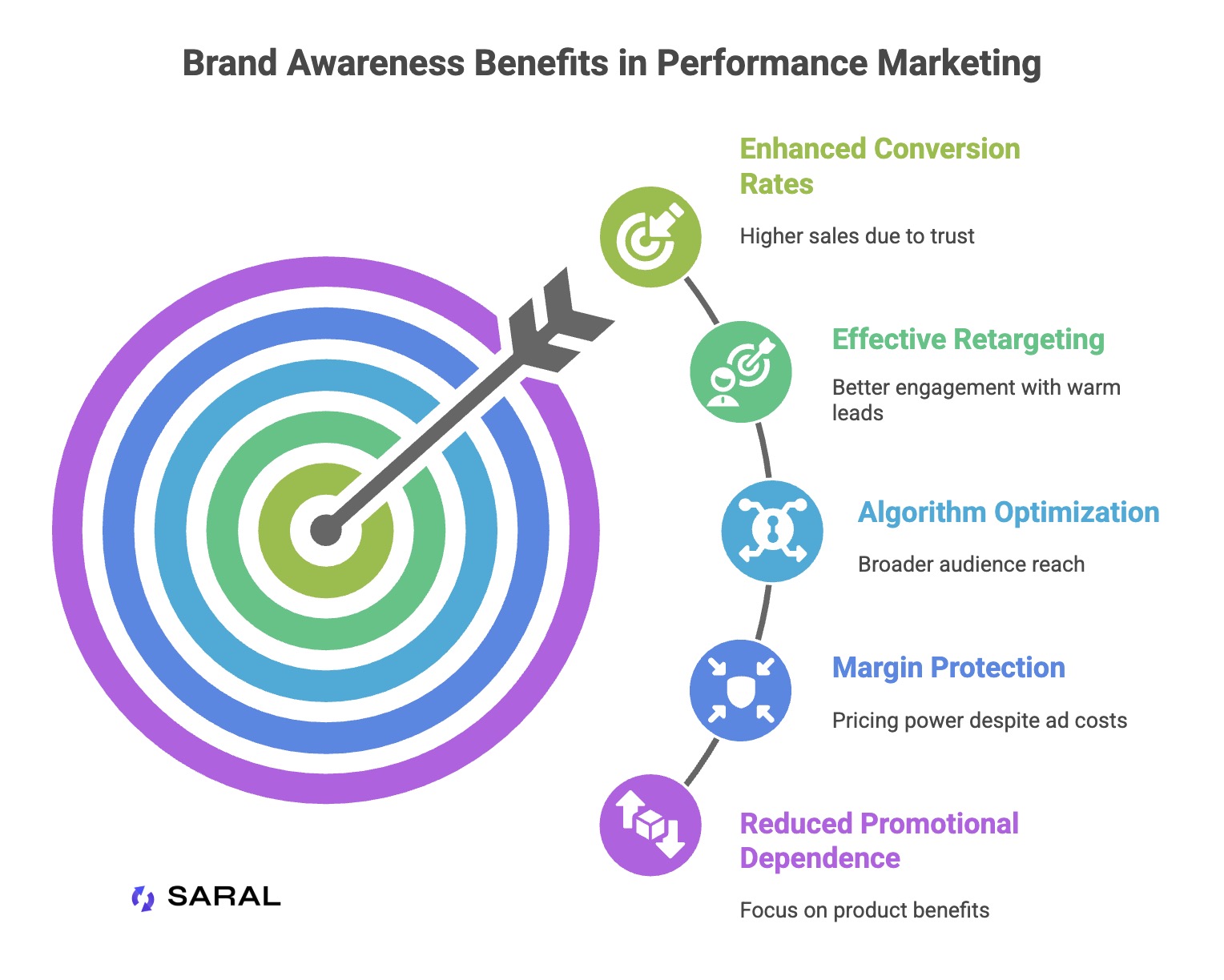
Here's where brand awareness creates the biggest performance marketing advantage: your retargeting campaigns work dramatically better when people already know who you are.
Someone who visited your site after hearing about your brand from a friend or seeing organic content will respond completely differently to retargeting ads than someone who randomly clicked an ad and bounced. They're already warm leads who just need the right motivation to purchase.
This means your retargeting campaigns can be less aggressive, more focused on offers rather than education, and more cost-effective because they're targeting people who are already predisposed to trust you.
According to the Awareness Advantage report by Tracksuit, engagement metrics like click-through rates correlate with conversion rates.
This means that building brand awareness doesn't just help with vanity metrics; it directly impacts the numbers that matter for your business.

Let's say, you're spending $10,000 monthly on ads with a 2% conversion rate at low brand awareness (20%), generating 200 conversions.
Simply by building your awareness to medium level (40%), that same $10,000 now converts at 2.96% (1.48x better), giving you 296 conversions.
That's 96 extra sales with zero additional ad spend.
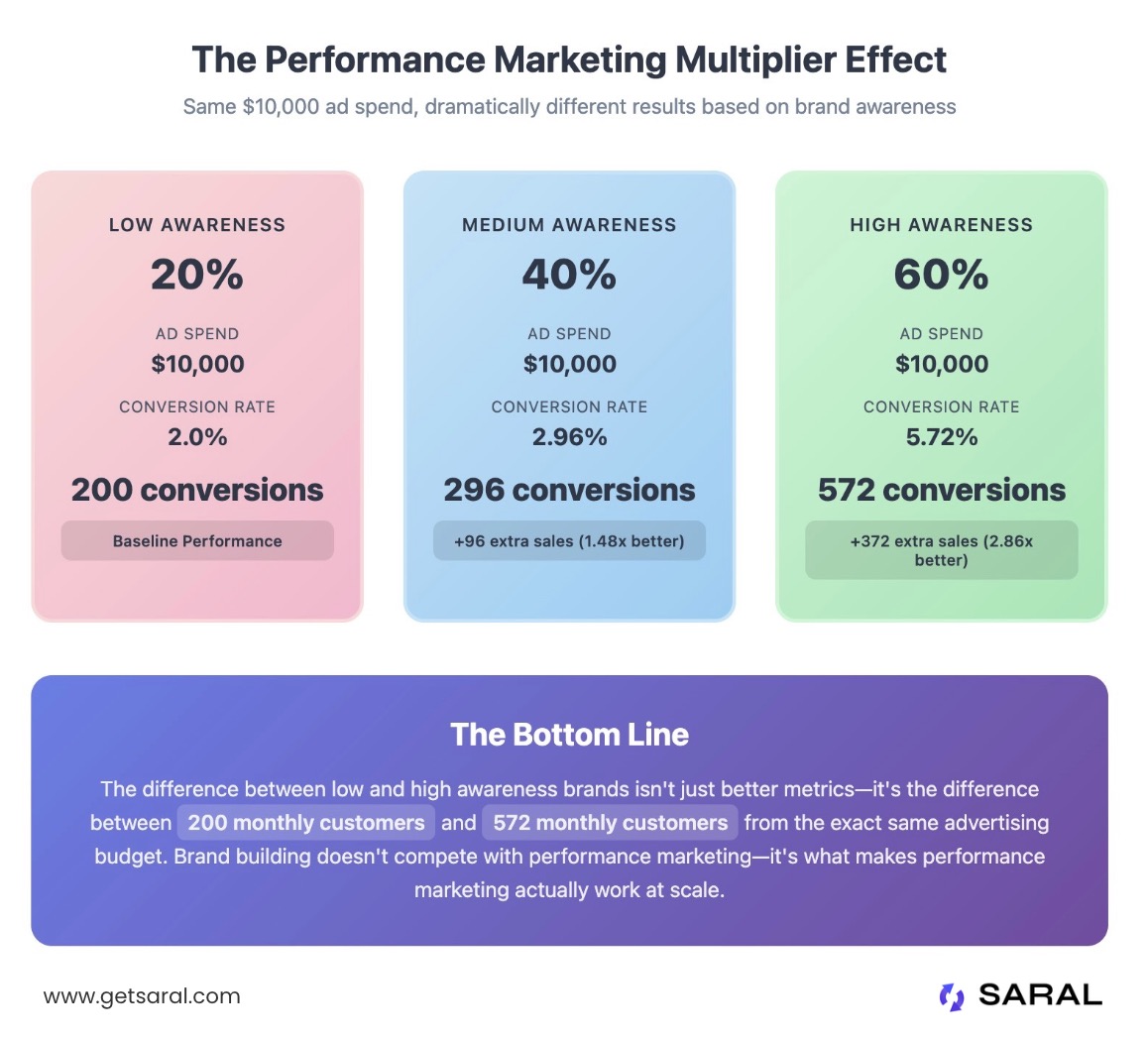
Scale that to high awareness (60%) and you're looking at 5.72% conversion rates (2.86x better), turning your $10,000 into 572 conversions.
That's 372 extra conversions. More than double compared to when you had low awareness.
To build brand awareness, most brands immediately think about expensive TV ads, billboards, or celebrity endorsements. But, there's a more strategic and cost-effective approach that's been quietly driving brand awareness for the smartest DTC companies, and it is…
It is a group of influencers who consistently promote your brand because they genuinely love your products and have a monetary or non-monetary incentive to keep talking about them.
With a billboard, you pay once for a fixed amount of reach that disappears the moment the campaign ends. The second you stop paying, your presence is gone.
With an owned influencer community, you’re investing in relationships that generate ongoing mentions and authentic content for months or even years. And unlike a billboard, every post created by your community lives on — people keep discovering it through feeds, hashtags, and search long after it was first published. Instead of vanishing impressions, you’re building a library of social proof that compounds over time.
An owned influencer community is different from one-off sponsored posts.
The 2 key differences are:
You're not going through agencies or relying on marketplaces to connect you with creators.
You have their contact information, you understand their audiences, and they understand your brand deeply enough to create authentic content consistently.
Instead of constantly hunting for new influencers and negotiating individual posts, you're developing ongoing relationships where creators continue posting about your brand without you having to nudge them every month.
These creators become invested in your success because they see the long-term value in the partnership—they're not just completing a transaction and moving on to the next brand.
Here's how to systematically build this type of influencer community that actually drives brand awareness:
Product seeding means sending your products to influencers for free, with no strings attached. The goal isn't immediate posts. It's identifying creators who genuinely connect with your products and can authentically represent your brand values.
Research and identify 100-150 creators who align with your brand values and target audience. Send products to 20-25 creators each week, spreading your investment over time. Include a thoughtful note explaining why you chose them specifically and how the product will help their audience.
Use this phase to test different niches.
Let's say you sell fitness products. Try bodybuilders one week, yoga instructors the next, and CrossFit athletes after that.
Look through your existing customer base for people who regularly post about products they love, or identify community members from relevant Facebook groups and Reddit communities.
Track who you contacted, when products were delivered, response rates, and most importantly, who posted organically. This data helps you understand which creator types resonate most with your brand.
Most brands begin managing influencers in spreadsheets, and that works fine for the first 20–30 creators. But once you start working with more, spreadsheets quickly become a bottleneck. Keeping track of conversations, updates, and follow-ups turns into hours of manual work every week.
That’s where a dedicated CRM comes in—not for the sake of having fancy software, but because it frees you up to focus on what really matters: building strong relationships with creators.
Tools like SARAL can help you build relationships at scale, moving creators through clear stages and giving you a visual pipeline of where each relationship stands.
Only invite creators who posted organically about your products to become official ambassadors. This exclusivity ensures you're working with people who are already genuine fans and understand your brand naturally, not just anyone willing to post for money.
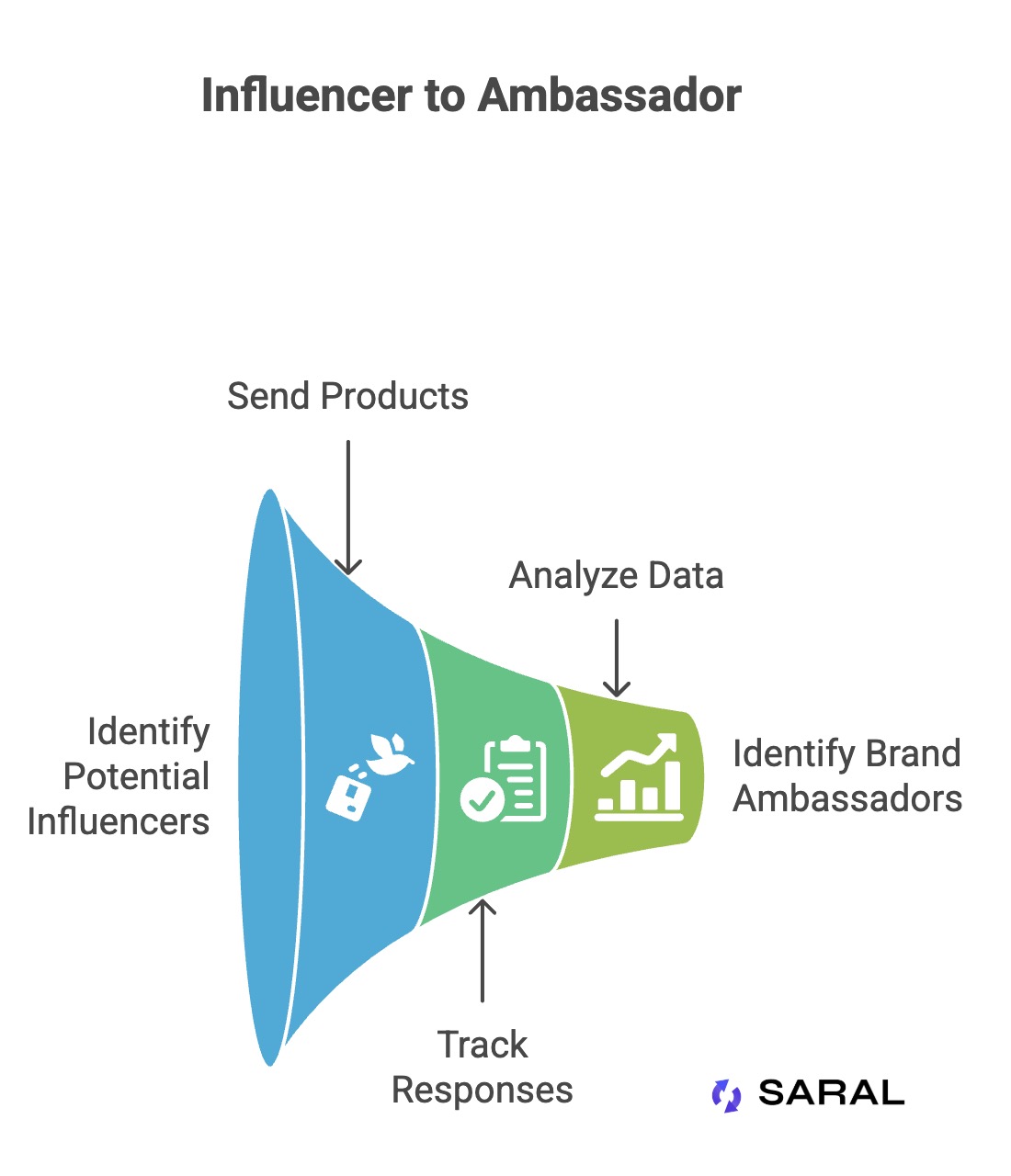
An ambassador program is a structured partnership where selected creators get ongoing benefits in exchange for regular content about your brand. Unlike one-time sponsored posts, ambassadors commit to promoting your brand consistently over months.
Send formal invitations to creators who posted organically, explaining the program benefits and expectations clearly. Your ambassador program should include:
Create onboarding materials that clearly explain your brand story, values, and the specific way you want to be represented. This ensures consistency in how your brand is portrayed across different creators.
Becca Harris, Influencer Marketing Manager at Otter Spirit, shared how her team approaches briefing influencers:
“We take a performance-oriented approach to influencer marketing. That means we constantly analyze what type of content actually drives results and share these insights with creators. We do provide some clear guidelines like including the code and link in the description, placing the mention in the first 60 seconds on YouTube, and connecting the jewelry to a personal or spiritual theme. At the same time, we leave plenty of creative freedom so the content stays authentic to their style.
One challenge many brands face is discount codes ending up on coupon sites, which means you're paying commissions on sales that weren't actually driven by your ambassadors. Choose a tool that gives you dynamic discount code. These are time-restricted, one-time-use codes that expire after use and thus can't be shared on deal forums.
Track sales from the unique codes and affiliate links, but also look at qualitative factors like whether influencers create content worth sharing on your own channels.
Pay attention to how their audience responds.
Are people asking genuine questions about your products in the comments, or just dropping emoji reactions? Do their posts accurately represent what your brand stands for?
The idea is to know who's driving sales and who's creating content that makes your brand relatable to the target audience.
After several months, you'll start seeing clear patterns.
Some ambassadors will consistently drive sales while creating content that makes your brand look amazing. Others might post occasionally, and some might not generate meaningful results at all.
This is where you separate the creators who are genuinely building your brand from those who are just posting for commission checks.
Track which ambassadors are your ‘top performers.’ Your "top performer" definition depends on your business goals.
You'll see the 80/20 rule in action. About 10% of your ambassadors will drive 80% of the impact, whether that's in sales or brand building.
For your best-performing ambassadors, offer them guaranteed monthly retainers instead of just commission. This moves them from earning only when they drive sales to getting predictable income for consistent posting.
Why do this?
If an ambassador generated $5,000 in sales over 3 months and earned $1,000 in commissions (at 20%), you can offer them $800/month guaranteed to post a set number of times. They get more predictable income, you get guaranteed content.
Calculate retainer amounts based on each creator's past performance. Track how many posts it took them to generate those sales—if they posted 6 times to make $5,000 in sales, you know asking for 8 posts per month for the retainer is reasonable.
You don't have to do all these calculations manually if you use SARAL.
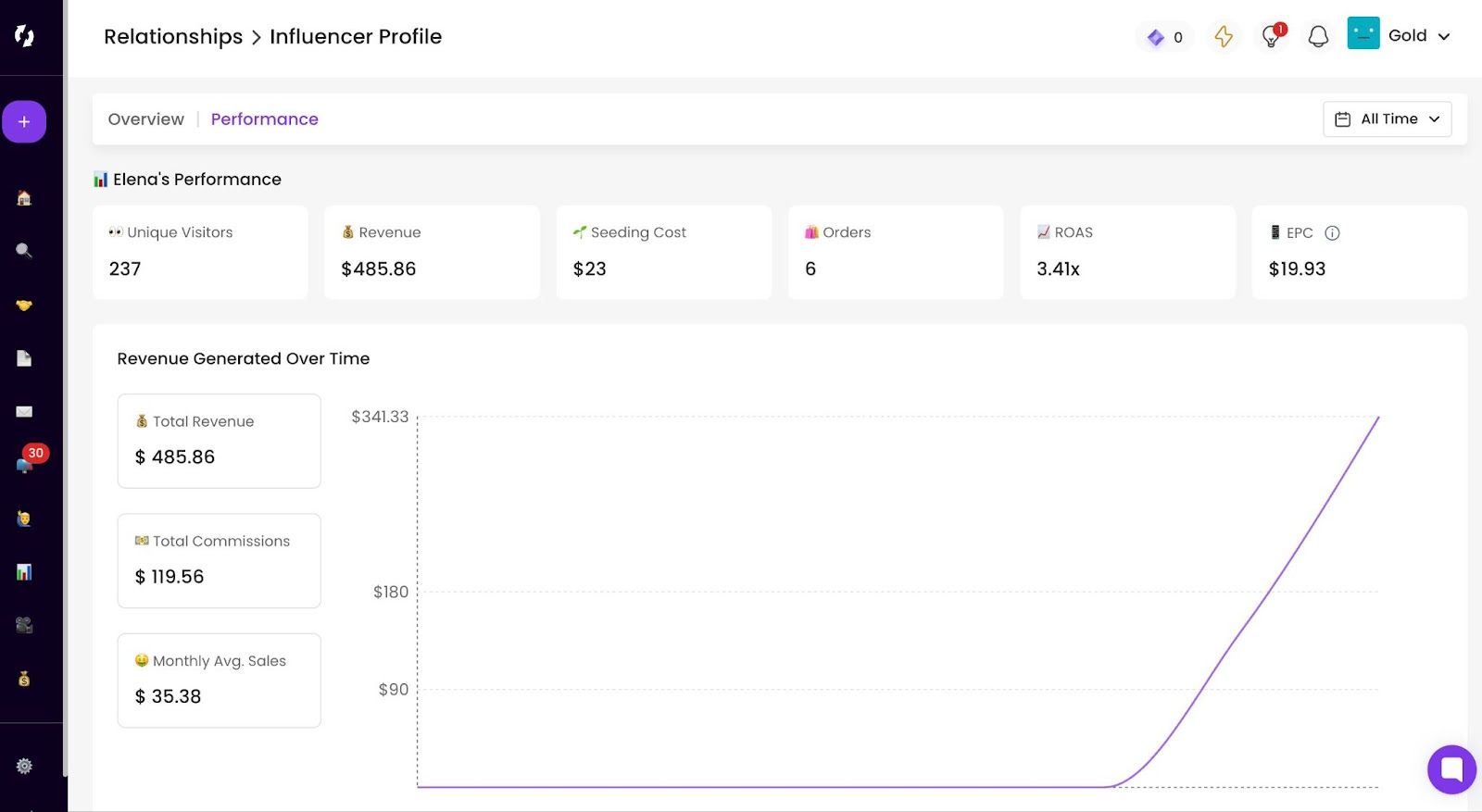
SARAL shows you a performance report for each influencer you onboard. You can track whether partners are meeting posting commitments, compare their performance before and after switching to retainers, and see the overall impact on your program's ROAS and revenue generation.
Create tiered partnership structures that unlock based on performance. Your top performers can earn additional opportunities like having their content amplified through your paid ads or getting revenue-share deals, but only after proving they can consistently drive sales.
Monitor whether your retainer partners are meeting their posting commitments and maintaining their sales performance.
Track the ROI of each retainer deal by comparing what you pay them monthly versus the sales they generate.
Also evaluate whether the guaranteed content is helping maintain consistent brand presence—you should see your brand mentioned regularly across social media without having to chase people down for posts.
You now understand the strategy but what about executing it? How do you plan to do that without drowning in spreadsheets and manual processes?
Most brands give up after a few months because managing hundreds of creator relationships becomes chaos.If you want to see how the top DTC brands are actually building these influence engines without the operational headaches, book a demo with SARAL. We'll show you exactly how brands are going from zero influencer relationships to 100+ active ambassadors posting consistently, all while tracking real ROI and not paying upfront for any posts.
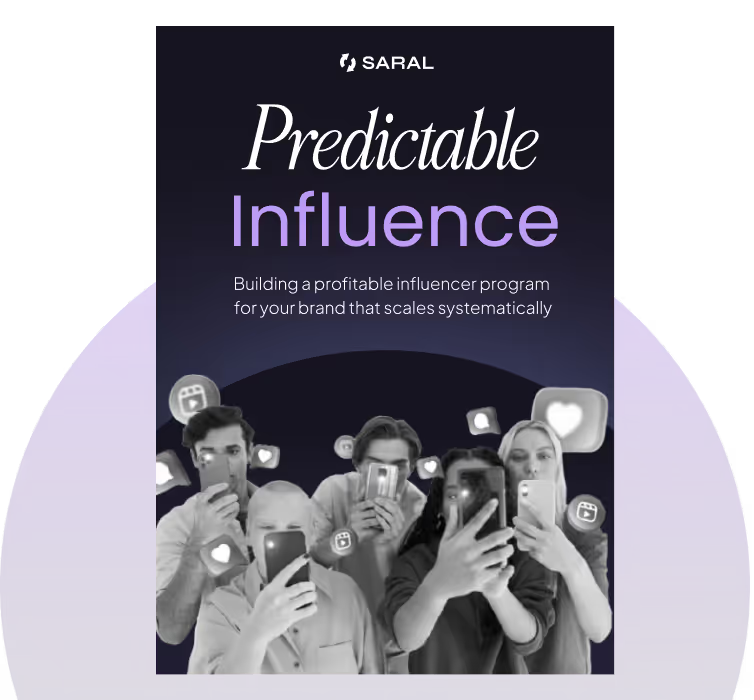
Sign up for a 7-day email course on the unique "Predictable Influence" strategy used by top brands like Grüns, Obvi, Tabs Chocolate.

If ditching the randomness of influencer campaigns and building a predictable, ROI-first influencer program sounds like a plan. Consider talking to our team!